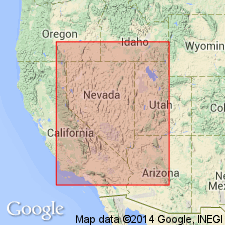
- Usage in publication:
-
- Lake Tecopa Allogroup
- Modifications:
-
- Named
- Dominant lithology:
-
- Siltstone
- Claystone
- Sandstone
- Tephra
- Gravel
- Paleosol
- AAPG geologic province:
-
- Great Basin province
Summary:
Named for ancient Lake Tecopa. Found in Lake Tecopa area, eastern Mojave Desert, vicinity of Amargosa River and towns of Shoshone and Tecopa, Inyo Co., east-central CA (Morrison, 1991). Consists of sedimentary deposits (clay, sand, silt, gravel, paleosols) interspersed with tephra beds that record Lake Tecopa's history. Assigned allogroup rank and divided into (ascending) late Miocene and Pliocene Spanish Trail Alloformation, late Pliocene and early Pleistocene Greenwater Fan Alloformation (including 2.02 Ma Huckleberry Ridge tephra layer at its base), early and late Pleistocene Shoshone Springs Alloformation (including 738 ka Bishop tephra layer at its base), and late Pleistocene Amargosa Alloformation (including 620 ka Lava Creek B tephra layer at its base (all new, except for tephra layers). A late Pleistocene (about 160 ka) unnamed tephra layer occurs within several meters of the top of the Amargosa (A. Sarna-Wojcicki, written communication, 1990). Total thickness is roughly 200 m [inferred]. Base of Lake Tecopa Alloformation is concealed and there is no overlying unit. Age ranges from late Miocene (>5 Ma) to late Pleistocene (160 ka). Age control from well-dated tephra layers (Sarna-Wojcicki and others, 1987; and Chapter 6 in this volume; Sarna-Wojcicki, personal communication, 1990).
Source: GNU records (USGS DDS-6; Menlo GNULEX).
For more information, please contact Nancy Stamm, Geologic Names Committee Secretary.
Asterisk (*) indicates published by U.S. Geological Survey authors.
"No current usage" (†) implies that a name has been abandoned or has fallen into disuse. Former usage and, if known, replacement name given in parentheses ( ).
Slash (/) indicates name conflicts with nomenclatural guidelines (CSN, 1933; ACSN, 1961, 1970; NACSN, 1983, 2005, 2021). May be explained within brackets ([ ]).

